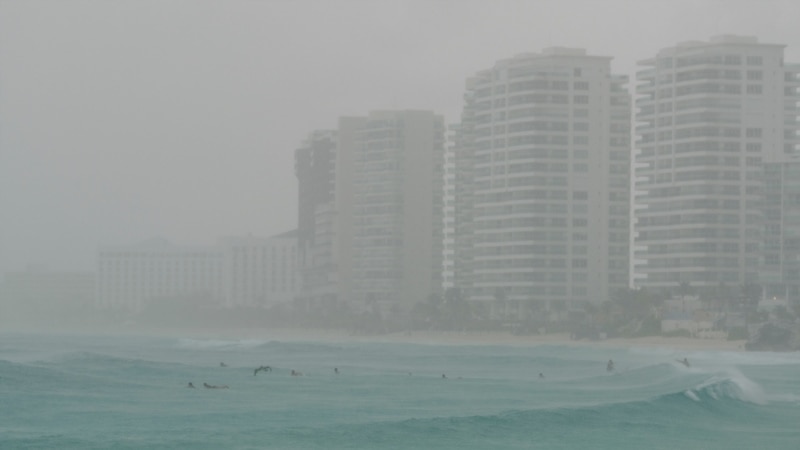Tropical Storm Helene was rapidly gaining strength in the Caribbean Sea and was expected to strengthen into a hurricane on Wednesday as it moved north along the coast of Mexico toward the United States, prompting evacuations, school closures and emergency declarations in Florida and Georgia.
Helene is expected to approach hurricane strength when it passes near Mexico’s Yucatan Peninsula early Wednesday, the U.S. National Hurricane Center (NHC) said, and is expected to “intensify and grow in size” as it heads north across the Gulf of Mexico. Heavy rains are expected in the southeastern United States beginning Wednesday, with a “potentially life-threatening storm surge” along the entire Florida coast, it added.
Helene is expected to become a Category 3 or stronger hurricane by Thursday, when it is expected to make landfall on the Florida Gulf Coast, the NHC said. The center issued hurricane warnings for parts of the Yucatan and Florida’s northwest coast, where storm surges of up to 15 feet (4.5 meters) are expected.
Mexico is still recovering from Hurricane John, which slammed into the southern Pacific coast on Monday night, killing two people and ripping tin roofs off homes, causing landslides and toppling dozens of trees, authorities said Tuesday.
John strengthened into a Category 3 hurricane within hours on Monday and made landfall 80 miles (128 kilometers) east of the resort city of Acapulco near Punta Maldonado with maximum sustained winds of 120 mph (193 kph) before weakening to a tropical storm as it moved inland.
Helene, which formed Tuesday in the Caribbean, is expected to move over deep, warm waters, fueling its intensification. People in areas under hurricane watches and warnings should be prepared for possible power outages and have enough food and water for at least three days, the forecast warned.
Hurricane warnings were also in effect for parts of western Cuba and Florida, including the Tampa Bay area, the NHC said.
“It’s going to be a very large system with impacts across Florida,” said Larry Kelly, a specialist at the center.
Several counties on Florida’s west coast and northwest have issued evacuation orders. Many school districts, including those around Tampa and the state capital, Tallahassee, plan to close schools or reduce instructional hours beginning Wednesday.
Some residents began filling sandbags in anticipation of flooding and began leaving coastal areas.
U.S. President Joe Biden declared an emergency in Florida and sent Federal Emergency Management Agency teams to Florida and Alabama to assist local emergency crews. Federal officials were positioning generators, food and water, as well as emergency response equipment and electrical repairs, the White House said.
Florida Governor Ron DeSantis also declared an emergency in most counties in the state, while Georgia Governor Brian Kemp also declared an emergency.
The storm is expected to be unusually large and move quickly, meaning storm surge, wind and rain will arrive far from its center, the NHC said. Inland states such as Tennessee, Kentucky and Indiana could see showers.
Heavy rain and high waves already hit the Cayman Islands on Tuesday. Authorities ordered schools, airports and government offices closed after powerful winds knocked out power in parts of Grand Cayman, and rainfall and waves as high as 10 feet (3 meters) caused flooding. Authorities urged people to stay indoors as the storm moved away Tuesday night and said crews would soon begin assessing the damage.
The storm was also a cause for concern for many in Cuba, as its outer bands were expected to reach the capital, Havana, which is suffering from a severe water shortage, mountains of uncollected garbage and constant power outages.
Helene is the eighth named storm of the Atlantic hurricane season, which began June 1. Since 2000, eight Category 3 or stronger hurricanes have made landfall in Florida, according to Philip Klotzbach, a hurricane researcher at Colorado State University.
The National Oceanic and Atmospheric Administration predicts this year’s Atlantic hurricane season will be above average due to record ocean temperatures. It expects 17 to 25 named storms before the season ends Nov. 30, with four to seven hurricanes of Category 3 or greater.
Connect with the Voice of America! Subscribe to our channels YouTube, WhatsApp and the newsletter. Activate notifications and follow us on Facebook, X and Instagram.


![[Img #74340]](https://thelatestnews.world/wp-content/uploads/2024/11/Artificial-intelligence-and-supercomputers-to-design-proteins-150x150.jpg)










Add Comment